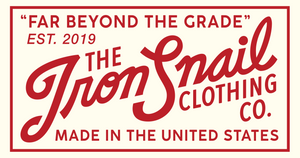
About Us
Dearest Reader,
First off, thank you for perusing the site and reading what we write. That’s awfully nice of you. Second, allow me to tell you a bit about "The Iron Snail."
Our (my) motto here at Iron Snail HQ is "Far Beyond The Grade." I don’t hear the phrase "made the grade" used much anymore, but whenever I do hear it in songs (David Bowie’s "Space Oddity" and The Beatles’ "A Day in The Life," for example), it always has a mystical feeling to it. That’s certainly aided by the overall vibe of those two songs, but still, that’s how I feel.
Anyway, "Far Beyond The Grade"—the philosophy behind the Snail. In short, "making the grade" means to succeed, to reach the desired standard. I’d like to smash through that standard and exceed what was previously thought possible in every facet of a clothing brand. A lofty, yet I believe, achievable goal. That’s rather broad, though, so let me set the mood:
The Tale
Perhaps you've noticed the phrase "The Tale of" everywhere and wondered to yourself, "What on Earth does that even mean?". Well, to put it simply, we here at The Iron Snail love fantastic* stories and figured, why can't we do that? And so we did.
Running through the "The Iron Snail" clothing brand is a story, a tale, if you will. The Tale of The Iron Snail is the grandest of them all, it's a story like no other, with no rivals...and if another clothing brand decides to write a multi-part story that comes with each and every garment they produce, then we shall battle to the death, and win.
To put it all very simply -- "The Tale of The Iron Snail" features a tiny snail, no larger than a quarter, with a glowing blue shell. The snail has been around well before the Earth and, in fact, is the reason grass is green and the sky is not. We'll be following our little friend throughout eternity but, in order to keep things organized, we've organized. Here is the current state of the tale as it rests.
The Lore Series
"The Lore Series" is precisely what it sounds like, the lore of the snail. "The Prologue" begins far, far after the snail does and so, there is a lot of backstory to catch up on. This series begins with "The Mammoth" and has no end in sight. We may, one day, consolidate this into some sort of compendium, but who is to say.
Okay, that's it. You're caught up. But what about the actual clothes?
*By the way, by "fantastic", we mean, based in fantasy. We'd never call ourselves fantastic, that's obtuse.
Far Beyond An Heirloom
The Philosophy
Be cheaper...and better.
The Iron Snail was born from a YouTube channel of the same name. While I (Michael) was trying to figure out how I could fairly review other brands' products while also trying to sell my own, I realized there was only one way to do it effectively: we have to offer far more than the competition does, and at a better price. This is, of course, subjective, and you may prefer another brand—that's quite alright—but the mission still stands. The Iron Snail is meant to be a beacon of fairness and an obsession with detail. Ideally, when reading about our products, the materials, and the construction techniques we use, you'll think, "Huh, that's kinda neat," at least once. We're a very young brand with a very small offering as of now, but we're on our way.
Made in The USA
Hey, that's where I live!
In the 19th and 20th centuries, the U.S. was considered one of the greatest textile manufacturing hubs in the world. Coincidentally, all of the major manufacturing hubs were around where I (Michael) grew up—in Massachusetts. Iron Snail products are now always cut and sewn in the USA. Some of our fabrics are sourced from the UK and Japan, but for the most part, we're working towards a USA-dominated supply chain, starting from the fiber level. By doing this, we're far more sustainable, we can easily and frequently visit all of our manufacturers to monitor quality, and it's much easier to ensure that everything down the line of our supply chain is ethical. The majority of our woven and knit fabrics are sourced less than a two-hour drive from where I grew up.
Our Pricing Philosophy
Heirloom quality, old school prices.
The clothing world feels pretty negative nowadays. Customers are frustrated—clothes are thinner, made cheaply, and priced high. That’s quite sad, especially when you want something to be a meaningful part of your life. To state the obvious, our prices aren’t cheap, but we price things as low as we possibly can without compromising quality. I (Michael) promise to give you my absolute best in creating astoundingly high-quality garments at the lowest sustainable price. I want The Iron Snail to be an honest transaction between you and me—no funny business. I want you to feel respected and thrilled with anything that comes out of our doors.
Optimization & Sustainability
Focusing on efficiency and modernity.
Iron Snail HQ is rather obsessive about materials and technologies, so it’s only fitting that we implement them everywhere we can in our production workflow. We’re constantly working on shortening the shipping journey our products take, finding more sustainable packaging methods, and ensuring the materials that go into our products are sourced responsibly. We're working on adding more detail to this section, so stay tuned.
Newsletter
Learn about product availability and see behind-the-scenes action, from cleaning raw sheep's wool to pressing pure copper rivets. This newsletter has it all! It's the best!
- Michael, Writer of The Newsletter

